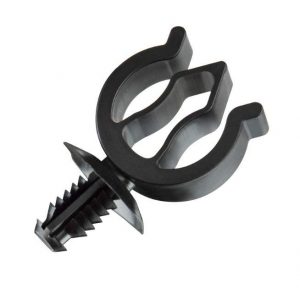As part of our Wire and Cable Management Buyer’s Guide, we asked manufacturers for some installation tips. Here is what they had to say.
Working off the roof. Installers are still doing most of the wire management assembly once they are up on the roof. We have seen several installers over the years save time (and money) by doing as much of the assembly as they can on the ground. The majority of wire management products on the market today allow for assembly that isn’t dependent on installation, meaning an installer can assemble the wire management device onto the cable(s) while on the ground and then attach the complete assembly to the modules (or racking system) once on the roof.
Similarly, an installer can assemble the wire management device onto the modules (or racking system) while on the ground and then insert the cable(s) once on the roof. If pre-installing the solution onto the cables (instead of on the modules or racking system), we suggest you do it “loosely” so you can make any final adjustments once everything is laid out on the roof since there will inevitably be small adjustments that need to be made.
-Tom Marsden, Renewable Energies Sales Manager, Heyco Products Corp.
No cross-mating. Probably the most common mistake I see in residential PV systems is the cross-mating of connector products from other manufacturers. It’s easy to understand how this happens: most of them look very similar, and unfortunately all too often connector products are marketed as compatible with other connectors. This can even be stated in the actual product manual of modules and MLPEs. This is a very dangerous marketing tactic, since the makers of those two different connectors almost certainly did not collaborate on their product designs.
When you take a moment to consider that these connections are expected to last 20+ years outside in all conceivable weather conditions, and protect an inordinately high level of DC energy (typical residential PV string inverter circuits are rated for >6kW), you can see how leaving the safety of these connections to a collection of guesses creates a dangerous situation. That is why you cannot get a connector certification for products from two different manufactures unless those companies agree to a joint certification, and it’s very rare for such a situation to exist.
In some cases, these connections survive without any appreciable effect on the system. In most cases they cause nuisance issues like blowing fuses, excessive power losses due to high heat generation, and creating repeated faults in the inverter (and even creating premature failure). But in some cases, and too often, these failures cause catastrophic issues including electrical arcing and fires. This is where a small oversight has very dire consequences, and since the NEC code requires that you use equipment certified for its intended use (and cross-mating connectors is rarely if ever certified), then the installer is inadvertently commissioning a system that is not code-compliant. It’s a must to ensure that all the connections made in the system are products from the same manufacturer.
-Brian Mills, Product Manager Alternative Energy, North America, Staubli
Pay attention to product details. For residential installers, the best thing to keep in mind when designing a system is to follow best practices. Having appropriate bend radius, not only when folding a wire over but coming out of module junction boxes and MLPE, can be critical to the life of the system. Keep wires safe and away from nesting opportunities. The wires are warm, and in colder climates animals will find them. Routing along the racking or tucking them on top of the module edge can help minimize those opportunities.
Plastic parts continue to suffer a bad reputation in the industry, but avoiding the cheapest cable ties at your local distributor and doing some basic research can go a long way. Plastics installed 10-15 years ago are still performing in some of the harshest environments. But even the best cable tie will fail prematurely when threaded through a sharp module hole. Metal can be a good solution, but careful consideration must be given to application as well. Metal is abrasive; installed improperly, it can easily damage your wires.
-Nick Korth, Product Marketing Manager, HellermannTyton
— Solar Builder magazine



Leave a Reply
You must be logged in to post a comment.